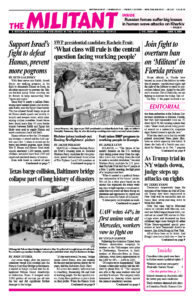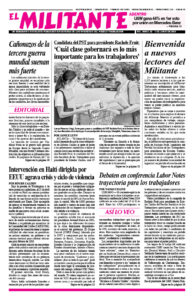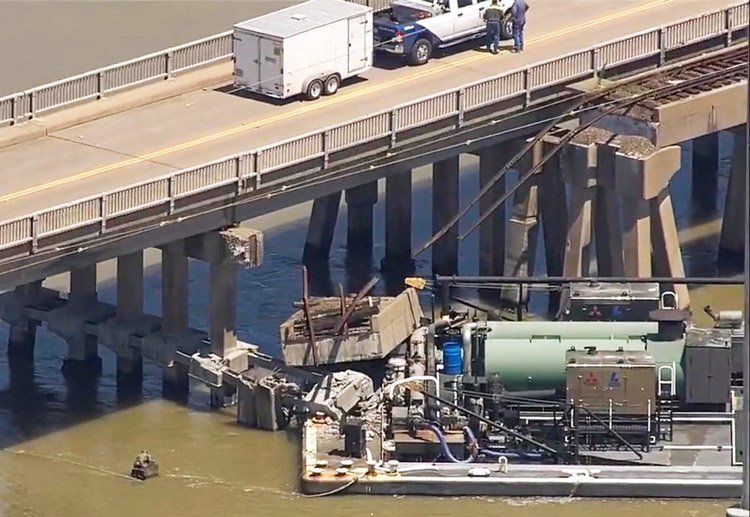Just seven weeks after the massive container vessel Dali crashed into the Francis Scott Key Bridge in Baltimore, a loaded oil barge crashed into the dilapidated Pelican Island drawbridge in Galveston, Texas. It dumped some 2,000 gallons of vacuum gas oil into the bay and did significant further damage to the bridge.
“It’s the worst wreck I’ve seen,” bridge tender David Flores, who had worked for the port and navigation district for 40 years, told the Galveston Daily News.
All across the country, infrastructure is crumbling, threatening life and limb of working people. For the capitalist rulers, fixing these problems is just a drain on their profits. When the Francis Scott Key Bridge collapsed six road workers were killed and the port of Baltimore was shut down, putting thousands of longshore and other workers out of work.
Authorities in Galveston shut down all traffic over the span that connects Galveston with the small island, which is home to a shipyard, other industrial operations and a Texas A&M University extension.
The crash happened after strong winds propelled the 321-foot-long barge, which broke away from a tugboat pulling it, into the bridge. Two crew members were unhurt after they either jumped or fell into the ship channel as large chunks of debris crashed down from the bridge onto the barge.
The bridge, built in 1960, was listed by state officials as “at the end of its structural life.” Chunks of its supporting pilings are gone. This was exacerbated when it was hit by another barge last July. Authorities said they had been considering rebuilding it.
The Texas Department of Transportation reports that of 53,018 bridges in the state, 1,025 are “structurally deficient” and 7,577 are “functionally obsolete.”
The New York Times reported May 15 that some 300 major bridges in the U.S. have protection systems that are “deteriorated, potentially outdated or nonexistent.” Decisions on what to do about this, it said, are based on “cost-benefit analysis.” That’s double-speak for saying if it’s too expensive, let it be.
“Vessel-bridge crashes have occurred with a certain regularity in recent decades,” the Times said. “Some of them — in places like Tampa Bay, Fla., Mobile, Ala., South Padre Island, Texas, and Webbers Falls, Okla. — have been catastrophic.”
In Tampa Bay, the freighter Summit Venture hit a support column on the Sunshine Skyway Bridge in 1980, sending a number of vehicles, including a Greyhound bus, into the bay, killing 35 people.
In Mobile, a tugboat pushing barges in dense fog in 1993 slammed into a railroad bridge. An Amtrak train heading toward Miami derailed on the bridge sending several cars into the water, killing 47 people and injuring 103.
A tugboat pulling four barges in 2001 hit the bridge connecting South Padre Island with Port Isabel in Texas. Drivers couldn’t see the missing spans and 10 cars drove off the bridge, killing eight and injuring three.
A tugboat lost control on the Arkansas River in 2002, sending barges crashing into an Interstate 40 bridge over the river in Webbers Falls, Oklahoma, whose center spans collapsed. Cars and tractor-trailers spilled into the water, killing 14 people.
Blame the workers
In Baltimore, the Dali was finally freed from massive bridge debris May 20 and towed to dock for temporary repairs. To allow for this, thousands of tons of mangled steel from the Francis Scott Key Bridge had to be gotten off the boat’s deck. This included a series of “controlled” explosions to cut it apart.
Cranes removed 182 of the 4,700 containers on the ship, some of which were intertwined with the wreckage of the bridge. The remaining containers will now be removed for shipping on other vessels.
The age of the bridge, lack of protection for the bridge’s piers and the fact it was built “fracture critical,” meaning a break anywhere would bring a substantial portion of the structure tumbling into the water, made it a disaster waiting to happen.
But the focus of the National Transportation Safety Board and the FBI is to blame the disaster on the boat’s 21 crew members, who are from India and Sri Lanka. They have not been allowed to leave the ship since the crash. Even during the “controlled” explosions, they were told to move to the back of the ship and sit tight.
“The crew is isolated from their families, fellow workers and the rest of the world,” said Rev. Joshua Messick, executive director of the Baltimore International Seafarers’ Center.
This is how capitalism works. It’s always the workers who get blamed, not the profit-driven bosses or their government.


